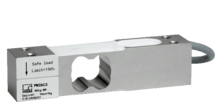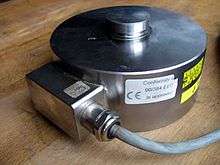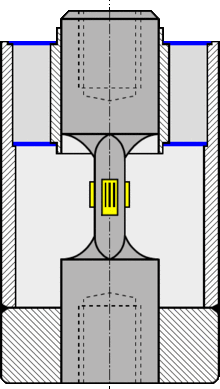Load cell
A load cell is a transducer that is used to create an electrical signal whose magnitude is directly proportional to the force being measured. The various types of load cells include hydraulic load cells, pneumatic load cells and strain gauge load cells.
Strain gauge load cell



Through a mechanical construction, the force being sensed deforms a strain gauge. The strain gauge measures the deformation (strain) as a change in electrical resistance, which is a measure of the strain and hence the applied forces. A load cell usually consists of four strain gauges in a Wheatstone bridge configuration. Load cells of one strain gauge (quarter bridge) or two strain gauges (half bridge) are also available.[1] The electrical signal output is typically in the order of a few millivolts and requires amplification by an instrumentation amplifier before it can be used. The output of the transducer can be scaled to calculate the force applied to the transducer. Sometimes a high resolution ADC, typically 24-bit, can be used directly.
Strain gauge load cells are the most common in industry. These load cells are particularly stiff, have very good resonance values, and tend to have long life cycles in application. Strain gauge load cells work on the principle that the strain gauge (a planar resistor) deforms/stretches/contracts when the material of the load cells deforms appropriately. These values are extremely small and are relational to the stress and/or strain that the material load cell is undergoing at the time. The change in resistance of the strain gauge provides an electrical value change that is calibrated to the load placed on the load cell.
Strain gauge load cells convert the load acting on them into electrical signals. The gauges themselves are bonded onto a beam or structural member that deforms when weight is applied. In most cases, four strain gauges are used to obtain maximum sensitivity and temperature compensation. Two of the gauges are usually in tension can be represented as T1 and T2,and two in compression can be represented as C1 and C2, and are wired with compensation adjustments. The strain gauge load cell is fundamentally a spring optimized for strain measurement. Gauges are mounted in areas that exhibit strain in compression or tension. When weight is applied to the load cell, gauges C1 and C2 compress decreasing their resistances. Simultaneously, gauges T1 and T2 are stretched increasing their resistances. The change in resistances causes more current to flow through C1 and C2 and less current to flow through T1 and T2. Thus a potential difference is felt between the output or signal leads of the load cell. The gauges are mounted in a differential bridge to enhance measurement accuracy.[2] When weight is applied, the strain changes the electrical resistance of the gauges in proportion to the load.[3] Other load cells are fading into obscurity, as strain gauge load cells continue to increase their accuracy and lower their unit costs.
Common shapes
There are several common shapes of load cells:
- Shear beam, a straight block of material fixed on one end and loaded on the other
- Double-ended shear beam, a straight block of material fixed at both ends and loaded in the center
- Compression load cell, a block of material designed to be loaded at one point or area in compression
- S-type load cell, a S-shaped block of material that can be used in both compression and tension (load links and tension load cells are designed for tension only)
- Rope clamp, an assembly attached to a rope and measures its tension. Rope clamps are popular in hoist, crane and elevator applications due to the ease of their installation; they have to be designed for a large range of loads, including dynamic peak loads, so their output for the rated load tends to be lower than of the other types
- Loadpin, used for sensing loads on e.g. axles
Common issues
- Mechanical mounting: the cells have to be properly mounted. All the load force has to go through the part of the load cell where its deformation is sensed. Friction may induce offset or hysteresis. Wrong mounting may result in the cell reporting forces along undesired axis, which still may somewhat correlate to the sensed load, confusing the technician.
- Overload: Within its rating, the load cell deforms elastically and returns back to its shape after being unloaded. If subjected to loads above its maximum rating, the material of the load cell may plastically deform; this may result in a signal offset, loss of linearity, difficulty with or impossibility of calibration, or even mechanical damage to the sensing element (e.g. delamination, rupture).
- Wiring issues: the wires to the cell may develop high resistance, e.g. due to corrosion. Alternatively, parallel current paths can be formed by ingress of moisture. In both cases the signal develops offset (unless all wires are affected equally) and accuracy is lost.
- Electrical damage: the load cells can be damaged by induced or conducted current. Lightnings hitting the construction, or arc welding performed near the cells, can overstress the fine resistors of the strain gauges and cause their damage or destruction. For welding nearby, it is suggested to disconnect the load cell and short all its pins to the ground, nearby the cell itself. High voltages can break through the insulation between the substrate and the strain gauges.
- Nonlinearity: at the low end of their scale, the load cells tend to be nonlinear. This becomes important for cells sensing very large ranges, or with large surplus of load capability to withstand temporary overloads or shocks (e.g. the rope clamps). More points may be needed for the calibration curve.
Excitation and rated output
The bridge is excited with stabilized voltage (usually 10V, but can be 20V, 5V, or less for battery powered instrumentation). The difference voltage proportional to the load then appears on the signal outputs. The cell output is rated in millivolts per volt (mV/V) of the difference voltage at full rated mechanical load. So a 2.96 mV/V load cell will provide 29.6 millivolt signal at full load when excited with 10 volts.
Typical sensitivity values are 1 to 3 mV/V. Typical maximum excitation voltage is around 15 volts.
Wiring
The full-bridge cells come typically in four-wire configuration. The wires to the top and bottom end of the bridge are the excitation (often labelled E+ and E−, or Ex+ and Ex−), the wires to its sides are the signal (labelled S+ and S−). Ideally, the voltage difference between S+ and S− is zero under zero load, and grows proportionally to the load cell's mechanical load.
Sometimes a six-wire configuration is used. The two additional wires are "sense" (Sen+ and Sen−), and are connected to the bridge with the Ex+ and Ex- wires, in a fashion similar to four-terminal sensing. With these additional signals, the controller can compensate for the change in wire resistance due to e.g. temperature fluctuations.
The individual resistors on the bridge usually have resistance of 350 Ω. Sometimes other values (typically 120 Ω, 1,000 Ω) can be encountered.
The bridge is typically electrically insulated from the substrate. The sensing elements are in close proximity and in good mutual thermal contact, to avoid differential signals caused by temperature differences.
Using multiple cells
One or more load cells can be used for sensing a single load.
If the force can be concentrated to a single point (small scale sensing, ropes, tensile loads, point loads), a single cell can be used. For long beams, two cells at the end are used. Vertical cylinders can be measured at three points, rectangular objects usually require four sensors. More sensors are used for large containers or platforms, or very high loads.
If the loads are guaranteed to be symmetrical, some of the load cells can be substituted with pivots. This saves the cost of the load cell but can significantly decrease accuracy.
Load cells can be connected in parallel; in that case, all the corresponding signals are connected together (Ex+ to Ex+, S+ to S+, ...), and the resulting signal is the average of the signals from all the sensing elements. This is often used in e.g. personal scales, or other multipoint weight sensors.
Wiring colors
The most common color assignment is red for Ex+, black for Ex−, green for S+, and white for S−.
Less common assignments are red for Ex+, white for Ex−, green for S+, and blue for S−, or red for Ex+, blue for Ex−, green for S+, and yellow for S−.[4] Other values are also possible, e.g. red for Ex+, green for Ex−, yellow for S+ and blue for S−.[5]
Piezoelectric load cell
Piezoelectric load cells work on the same principle of deformation as the strain gauge load cells, but a voltage output is generated by the basic piezoelectric material - proportional to the deformation of load cell. Useful for dynamic/frequent measurements of force. Most applications for piezo-based load cells are in the dynamic loading conditions, where strain gauge load cells can fail with high dynamic loading cycles.
Hydraulic load cell
The cell uses conventional piston and cylinder arrangement. The piston is placed in a thin elastic diaphragm. The piston doesn't actually come in contact with the load cell. Mechanical stops are placed to prevent over strain of the diaphragm when the loads exceed certain limit. The load cell is completely filled with oil. When the load is applied on the piston, the movement of the piston and the diaphragm results in an increase of oil pressure which in turn produces a change in the pressure on a Bourdon tube connected with the load cells. Because this sensor has no electrical components, it is ideal for use in hazardous areas.[6] Typical hydraulic load cell applications include tank, bin, and hopper weighing.[7] By example, a hydraulic load cell is immune to transient voltages (lightning) so these type of load cells might be a more effective device in outdoor environments. This technology is more expensive than other types of load cells. It is a more costly technology and thus cannot effectively compete on a cost of purchase basis.[8]
Pneumatic load cell
The Load cell is designed to automatically regulate the balancing pressure. Air pressure is applied to one end of the diaphragm and it escapes through the nozzle placed at the bottom of the load cell. A pressure gauge is attached with the load cell to measure the pressure inside the cell. The deflection of the diaphragm affects the airflow through the nozzle as well as the pressure inside the chamber.
Other types
Other types include vibrating wire load cells, which are useful in geomechanical applications due to low amounts of drift, and capacitive load cells where the capacitance of a capacitor changes as the load presses the two plates of a capacitor closer together.
Ringing
Every load cell is subject to "ringing" when subjected to abrupt load changes. This stems from the spring-like behavior of load cells. In order to measure the loads, they have to deform. As such, a load cell of finite stiffness must have spring-like behavior, exhibiting vibrations at its natural frequency. An oscillating data pattern can be the result of ringing. Ringing can be suppressed in a limited fashion by passive means. Alternatively, a control system can use an actuator to actively damp out the ringing of a load cell. This method offers better performance at a cost of significant increase in complexity.
Uses
Load cells are used in several types of measuring instruments such as laboratory balances, industrial scales, platform scales[9] and universal testing machines.[10] From 1993 the British Antarctic Survey installed load cells in glass fibre nests to weigh albatross chicks.[11] Load cells are used in a wide variety of items such as the seven-post shaker[12] which is often used to set up race cars.
See also
References
- ↑ "Wheatstone Bridge Diagrams and Equations". Transducer Techniques.
- ↑ http://archives.sensorsmag.com/articles/0500/52/
- ↑ http://www.vishaypg.com/docs/11866/vpg-01.pdf
- ↑ http://www.aicpl.com/brochures/loadapp.pdf
- ↑ http://www.s-e-g.com/documents/Load%20Cells/Type%20K/F31-16E.PDF
- ↑ http://www.cardinalscale.com/wp-content/uploads/2012/04/Hydraulic-Load-Cell-Advantages.pdf
- ↑ http://www.centralcarolinascale.com/hydraulic-load-cells-overview.htm
- ↑ http://www.emerywinslow.com/technology.html
- ↑ http://www.aandd.jp/products/weighing/loadcell/introduction/loadcells_qa_02.html
- ↑ "Load cell testing gets straight to the point". Maritime Journal. Mercator Media. 20 December 2010.
- ↑ Highfield, Roger. Antarctic's birds thrive on warmth, The Daily Telegraph 18 August 1993
- ↑ http://www.searchautoparts.com/motorage/training/racecar-science
Standards
- ASTM E4 - Practices for Force Verification of Testing Machines
- ASTM E74 - Practice for Calibration of Force Measuring Instruments for Verifying the Force Indication of Testing Machines
- NTEP - National Conference on Weights and Measures (Certificate of Conformance)